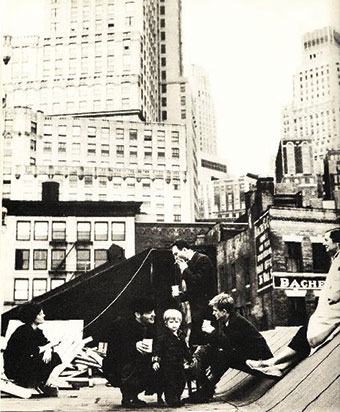Next story: Work by Andrzej Maciejewski and Lynn Richardson at Buffalo Arts Studio
Albright Knox Reveals a Seldom-seen Period in Painter Agnes Martin's Career
by J. Tim Raymond


A Nearly Lost Decade
The photo was taken on the roof of No. 23 Coenties Slip; in repose from the left, the French actress Delphine Serige, (she late of the film Last Year at Marianbad) married to painter Jack Youngerman, his little son, then artists Robert Indiana, Ellsworth Kelly, and, diagonal to the scene, Agnes Martin, resting on a rooftop abutment. Yes, painter Agnes Martin, she of the delicate palette, the singular geometric vocabulary, the hand-wrought gridded vistas of sublime infinities.
Courted by the Betty Parsons Gallery, Martin has just moved to Manhattan from the Southwest after several years in Taos, New Mexico. It is 1957.
The Albright Knox Art Gallery has done Martin’s legacy (she died in 2004 at age 92) a great favor by placing on view a selection of the artist’s work before her acclaimed breakthrough into her signature style in the 1960s.
Born in the western Canadian province of Saskatchewan, Martin moved to the US in 1931, became a citizen in 1950, and attended Teachers College at Columbia University. She chose to live in Taos, New Mexico following a summer field program at the University of New Mexico, Albuquerque, later teaching art courses there before returning to Columbia University to graduate with a MA in 1952. During her studies in Eastern philosophy, she attended a lecture by the Zen Buddhist scholar D. T. Suzuki, and she adopted the secular aspects of that discipline as a practical guide for life. Her observations of desert terrain during her post-graduate years in New Mexico resulted in the artworks presently displayed in the Albright Knox’s Agnes Martin: The New York-Taos Connection (1947-1957) exhibition. What is remarkable, aside from the work on display, is Martin’s dogged effort to seek and destroy all her paintings from that transitional period; more than 100 early works were reclaimed and disposed of. Only the fortunately traded or purchased pieces survived Martin’s attempts to destroy all evidence of that exploratory decade.

Beginning with her first solo show at Betty Parson’s Gallery in 1960, the distillation of her process and inspiration was influenced by the primarily male environment of studio arrangements at Coenties Slip, where her studio mates and gallery affiliates included Ellsworth Kelly, Mark Rothko, and Ad Reinhardt. Barnett Newman, too, was a strong supporter, and she followed his efforts, and the efforts of artists such as Adolph Gottlieb, William Baziotes, and Yves Tanguy, to try to break from Surrealism, Modernism, and post-war Abstract Expressionism, with its emphasis on “action painting.”
Wrestling with this difficulty, Martin stopped painting for seven years to travel the Southwest and Pacific Northwest in a pickup truck towing an Airstream trailer, processing Native American motifs, especially the biomorphic shapes and gestural marking of rock paintings. Returning to New York, Martin soon moved from her earlier paintings in a semi-figurative mode derived from shapes found in nature: bones, shells, and pebbles to purely abstract compositions resembling almanac charts and quilt patterns.
Following the death of Ad Reinhardt in 1967 and the demolition of the lofts at Coenties Slip, she returned for good to New Mexico. The subdued palette of earth colors Martin found in Southwest Indian art—neutral tones of grey, yellow, and white modulated with black—found its way into her new work now without references to pre-war Modernist color or Surrealist biomorphic forms, but retaining in a symbolic reduction to pure line in space the natural motif of desert earth and sky.
In her ongoing effort to shape her legacy, Agnes Martin very nearly severed a vital link in post-war Abstract Expressionism to the art of the present day. Her paintings are a continuing inspiration to contemporary artists. Agnes Martin: The New York-Taos Connection (1947-1957) argues for a more holistic understanding and reexamination of the art of an American original.
blog comments powered by Disqus|
Issue Navigation> Issue Index > v12n9 (Week of Thursday, February 28) > Art Scene > Albright Knox Reveals a Seldom-seen Period in Painter Agnes Martin's Career This Week's Issue • Artvoice Daily • Artvoice TV • Events Calendar • Classifieds |









 Current Issue
Current Issue